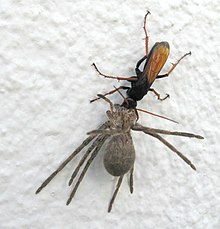Palystes castaneus
| Palystes castaneus | |
|---|---|

| |
| Scientific classification | |
| Domain: | Eukaryota |
| Kingdom: | Animalia |
| Phylum: | Arthropoda |
| Subphylum: | Chelicerata |
| Class: | Arachnida |
| Order: | Araneae |
| Infraorder: | Araneomorphae |
| Family: | Sparassidae |
| Genus: | Palystes |
| Species: | P. castaneus
|
| Binomial name | |
| Palystes castaneus Latreille, 1819
| |
| Synonyms | |
| |
Palystes castaneus is a species of huntsman spider found in South Africa.[1] It is common from Cape Town to Heidelberg, Western Cape, especially in forested areas. In scrub outside forested areas, it is replaced by Palystes superciliosus. It occurs mainly on plants, where it hunts insects. It has a body length of 17–22 mm.[2] P. castaneus is the type species for the genus Palystes, and was first described by Pierre André Latreille in 1819.[1]
Spiders in the genus Palystes are commonly called rain spiders, or lizard-eating spiders.[3] P. castaneus often appears in the home just before the onset of rain, where they hunt geckos (usually Afrogecko porphyreus). Males are regularly seen from August to December, probably looking for females.[2]

After mating in the early summer, the female constructs a round egg sac about 60–100 mm in size made of silk, with twigs and leaves woven into it. These egg sacs are commonly seen from about November to April. The female constructs the sac over 3–5 hours, then aggressively guards it until the spiderlings, who hatch inside the protective sac, chew their way out about three weeks later. Many gardeners are bitten by protective Palystes mothers during this period. Females will construct about three of these egg sacs over their two-year lives.[2]

P. castaneus (and other Palystes spiders) are also commonly seen paralysed, being dragged by a large wasp called a Pompilid wasp. Sometimes the wasp will not be present. Pompilid wasps only hunt spiders, which they paralyse by stinging them. They then drag the spider back to their nest where they lay an egg on the spider, then seal the spider and the egg in. When the egg hatches, the larva eats the paralysed spider, keeping the spider alive as long as possible by eating peripheral flesh first, and saving the vital organs till last. By doing this, the spider stays fresh long enough for the wasp larva to mature and pupate.[3] The Pompilid wasp species Tachypompilus ignitus is at least largely a specialist hunter of mature Palystes females.[4]
Gallery
-
Female P. castaneus
-
Female P. castaneus
-
Female P. castaneus
References
- ^ a b Platnick, Norman I. (10 December 2011). "Fam. Sparassidae". The World Spider Catalog, Version 12.5. New York, NY, USA: American Museum of Natural History. doi:10.5531/db.iz.0001. Retrieved 16 April 2012.
- ^ a b c Larsen, Norman. "Palystes castaneus". Biodiversity Explorer. Cape Town, South Africa: Iziko museums. Retrieved 16 April 2012.
- ^ a b Larsen, Norman. "Palystes". Biodiversity Explorer. Cape Town, South Africa: Iziko museums. Retrieved 16 April 2012.
- ^ Picker, Mike; Griffiths, Charles; Weaving, Alan (2004). Field Guide to Insects of South Africa (Updated ed.). Cape Town, South Africa: Struik. p. 402. ISBN 978-1-77007-061-5. OCLC 56338396.
External links
- Palystes castaneus on Iziko Museums' Biodivesity Explorer



